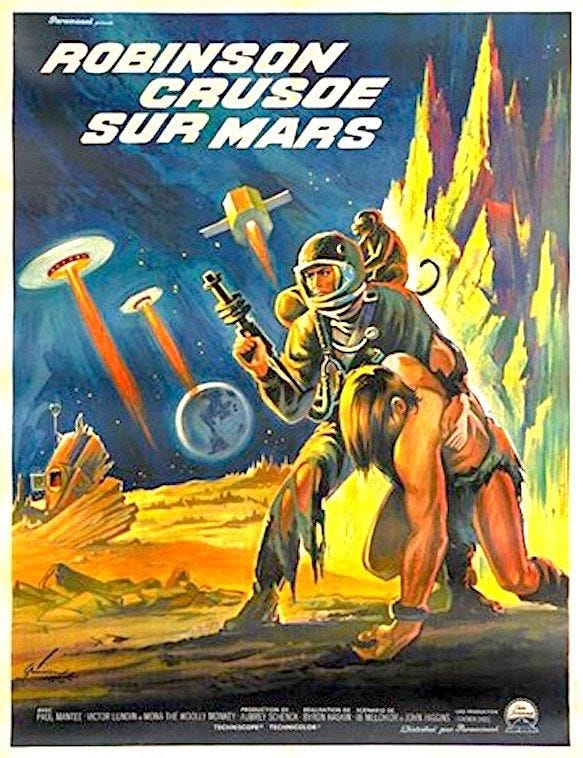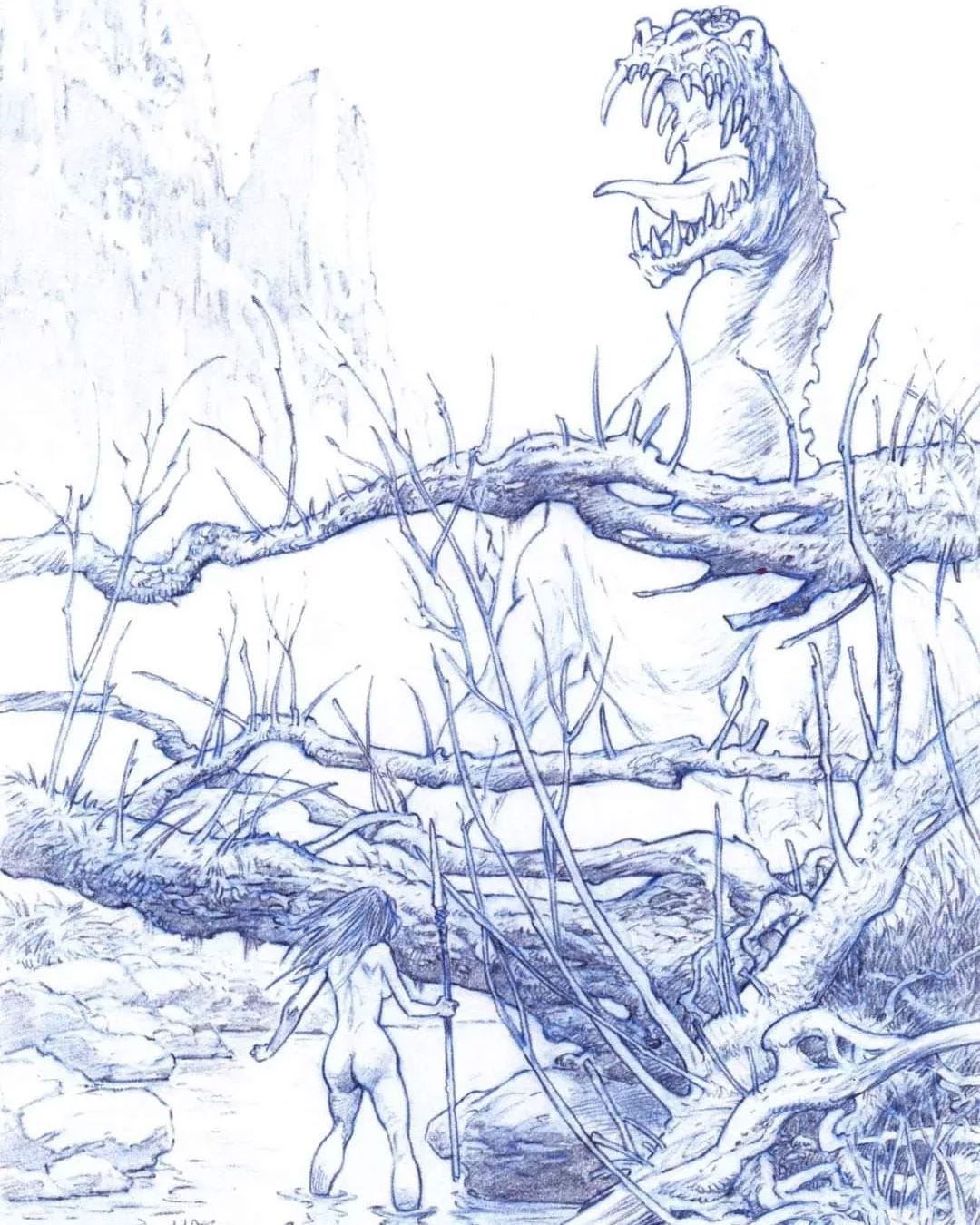Stranded in the Stars: Sci-Fi’s Classic Marooned-on-Alien-Planets Tales
...and a Peek at Escape From Planet Omega-12
There’s something timeless about being lost on an alien world. The sky’s wrong, the ground’s alive with strangeness, and survival’s down to you with no backup and no safety net. It’s a setup science fiction has leaned on for decades, pulling us into stories of grit, wonder, and the raw edge of human (or inhuman) endurance. I’ve been captivated by these tales since I was a kid, and they’re a big part of why I’m making Escape From Planet Omega-12, my own stab at the trope. Before I get into that, though, let’s rewind through some of the classics that paved the way, both on the page and the screen.
From Shipwrecks to Starscapes
This whole idea didn’t start with spaceships, of course. Daniel Defoe’s Robinson Crusoe (1719) was first, as far as I can tell. A man shipwrecked on an island, turning nothing into something. If we trade the ocean for space, we’re already halfway there. Then came Edgar Rice Burroughs with A Princess of Mars (1912), dropping John Carter on a red planet full of warring tribes and weird beasts. Those pulpy adventures that artist Frank Frazetta would later codify with his spectacular book covers lit the fuse for sci-fi’s love affair with planet marooning.
When cinema got hold of it, especially in the ‘50s and ‘60s, it exploded. Cold War vibes and the space race made these stories feel urgent; humans testing their mettle against the cosmic unknown. They’re not just about staying alive; they dig into isolation, identity, and what it means to be stranded far from home without knowing if you’ll ever be reunited with what matters to you.
The Classics
Here’s a rundown of the standout films that worked this trope before the millennium hit. These are the ones that stuck with me, and they’re all echoes in Escape From Planet Omega-12 one way or another:
** Forbidden Planet (1956)** – A crew lands on Altair IV, finding Dr. Morbius and his daughter holed up with a robot and a mind-bending monster. The practical effects and retro optimism still hold up.
** Robinson Crusoe on Mars (1964)** – An astronaut crashes on Mars with a monkey sidekick, scraping by until he meets an alien slave. It’s pure survival with a heart of grit.
** Planet of the Vampires (1965)** – Mario Bava’s creepy masterpiece strands a crew on a foggy planet littered with dead explorers. It’s got atmosphere for days and a vibe that lingers.
** Planet of the Apes (1968)** – Charlton Heston’s Taylor crash-lands on a world where apes run the show. That twist at the end? Still a gut-punch.
** Enemy Mine (1985)** – A human and an alien soldier crash on a harsh rock and go from enemies to family. It’s raw, messy, and quietly beautiful.
These films are the backbone of the trope—each one a mix of practical magic, big ideas, and that stranded-alone feeling but with other movies from Star Trek, Star Wars, and Alien to Angry Red Planet, Green Slime, and the 80s Roger Corman era of sci-fi/adventure, well… they’re why I keep coming back to this corner of the genera.
My Turn: Escape From Planet Omega-12
That brings me to Escape From Planet Omega-12—a film that carries the soul of the classics while carving its own path. This is a story of survival, resilience, and rediscovery. Tara isn’t a solder, a warrior, or a leader. She just wanted to travel the galaxy with her husband and start a family. When her ship crashes onto Omega-12, she is thrown into a world of towering rock formations and primeval beasts, a place teeming with mysteries both wondrous and terrifying. Her only companions are a hovering, ever-watchful yet child like robot, a strange and fragile creature that has bonded to her, and the echoes of her husband's voice, now entwined with an ancient, sentient mass that stands as her only defense against the horrors that prowl the land.
This is not just another adventure in the stars. It is a deeply personal tale, steeped in themes of loss, survival, and the strength to rebuild, driven by pulse pounding adventure the likes of which have been missing from movies for a while, now. It is about what it means to be alone, what it takes to find family in the most unexpected places, and what a person can become when pushed beyond what they assumed are their limits but also told in a way that is sexy and fun.
I am bringing this vision to life with the ingenuity of independent filmmaking, merging traditional craftsmanship with cutting-edge AI tools. Miniatures sculpted by hand, practical effects puppets inspired by the golden age of sci-fi, and AI-assisted animation techniques come together to form a world that feels tangible, yet dreamlike, a canvas of the surreal, painted with pulp-fiction sensibilities. Forbidden Planet meets Burroughs' Mars, but with a rawness that can only come from an artist working at the edge of what is possible. This isn’t about replacing artistry with technology. It’s about expanding what can be done with a small but dedicated team.
The journey to bring Escape From Planet Omega-12 to life will take some time—12 to 18 months of passion, and discovery, if all goes well. When it’s ready, it will find its home as part of a larger sci-fi series that will start with the theatrical release of the pilot movie, alongside behind-the-scenes insights on YouTube that unravel the process of its creation, hopefully leading to an expanded set of stories of space travel and the future.
A Legacy That Endures
Stories of isolation on alien worlds endure because they reveal something essential about the human condition. They strip away the comforts of civilization, technology, security, the familiar, and confront us with something elemental. Forbidden Planet delves into the unseen depths of the mind. Enemy Mine explores the bonds that can form between the most unlikely of allies. Robinson Crusoe on Mars is a meditation on endurance, where survival is an act of quiet defiance. Each of these tales is a monument to resilience, a testament to the will to persist even when the universe itself seems to have forgotten you.
With Escape From Planet Omega-12, I seek to carry that tradition forward; not as mere homage, but as a continuation of the legacy. Tara’s struggle is not just about battling the alien wilderness; it is about reclaiming her strength, piecing together what was lost, and forging a path forward in the face of the unknown, and maybe even discover something new. Her journey echoes those who came before her, yet it is uniquely her own; a story of transformation, of finding light in the vastness of space.
This film is more than an experiment in storytelling; it is a statement of belief. That science fiction, even in its most daring and ambitious forms, can remain deeply human. That wonder and adventure still have the power to move us. That no matter the scale, stories can still reach into the heart and ignite the imagination, no matter what tools we use to bring it to life.
An Invitation to the Unknown
The great science fiction tales have always been an invitation to explore, to question, to dream. They ask us what we would do if the universe became a gulf between us and everything we know, and they answer with stories that resonate long after the screen fades to black. As I pour myself into Escape From Planet Omega-12, that same question drives me. That same longing for discovery, for meaning, for something greater than ourselves.
This is a journey I want to share, not just the final film, but the path that leads there. The triumphs and setbacks, the revelations and challenges, the moments where everything comes together. If these classics have ever stirred something in you, then I invite you to join me in exploring Omega-12. A world waits to be uncovered. A story waits to be told.








OK What title are you referring to here (RCOM)?
Interesting. I was not familiar with RCOM but I'll take alook.